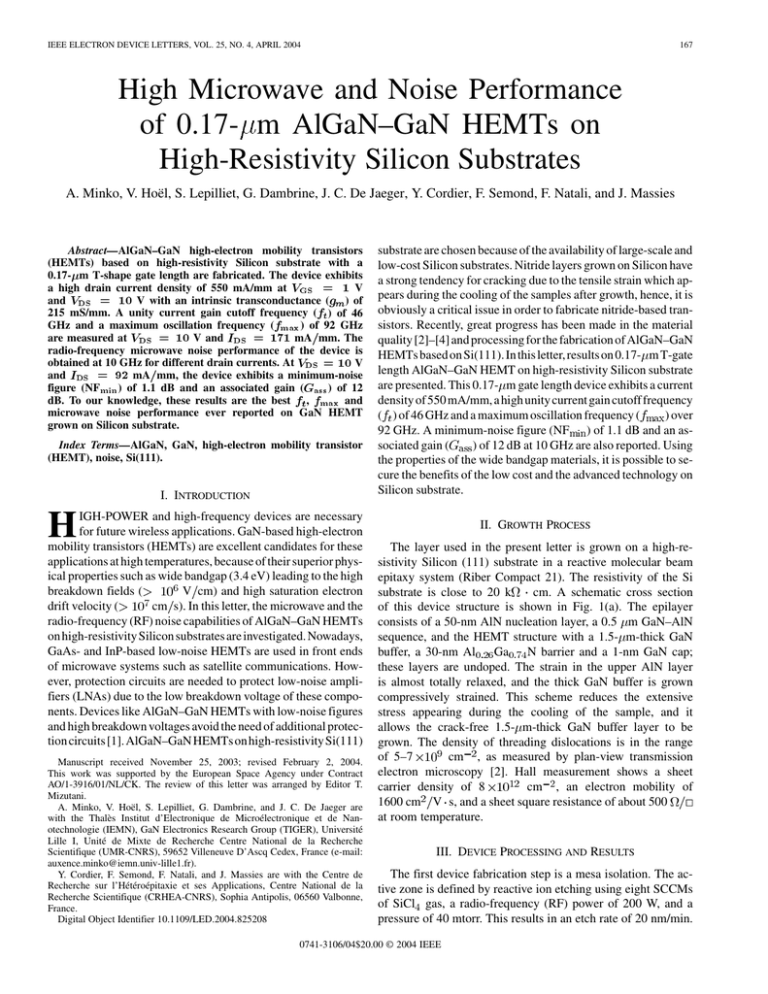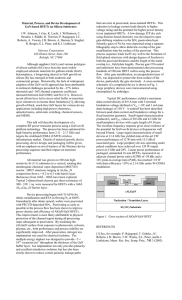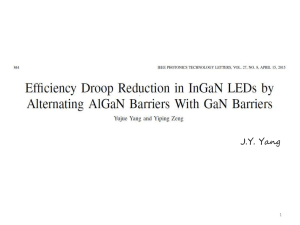Volume 25, Issue 4, April 2004 Page(s):167
advertisement

IEEE ELECTRON DEVICE LETTERS, VOL. 25, NO. 4, APRIL 2004 167 High Microwave and Noise Performance of 0.17-m AlGaN–GaN HEMTs on High-Resistivity Silicon Substrates A. Minko, V. Hoël, S. Lepilliet, G. Dambrine, J. C. De Jaeger, Y. Cordier, F. Semond, F. Natali, and J. Massies Abstract—AlGaN–GaN high-electron mobility transistors (HEMTs) based on high-resistivity Silicon substrate with a 0.17- m T-shape gate length are fabricated. The device exhibits a high drain current density of 550 mA/mm at GS = 1 V and DS = 10 V with an intrinsic transconductance ( ) of 215 mS/mm. A unity current gain cutoff frequency ( ) of 46 GHz and a maximum oscillation frequency ( max ) of 92 GHz are measured at DS = 10 V and DS = 171 mA mm. The radio-frequency microwave noise performance of the device is obtained at 10 GHz for different drain currents. At DS = 10 V and DS = 92 mA mm, the device exhibits a minimum-noise figure (NFmin ) of 1.1 dB and an associated gain ( ass ) of 12 dB. To our knowledge, these results are the best , max and microwave noise performance ever reported on GaN HEMT grown on Silicon substrate. Index Terms—AlGaN, GaN, high-electron mobility transistor (HEMT), noise, Si(111). I. INTRODUCTION H IGH-POWER and high-frequency devices are necessary for future wireless applications. GaN-based high-electron mobility transistors (HEMTs) are excellent candidates for these applications at high temperatures, because of their superior physical properties such as wide bandgap (3.4 eV) leading to the high V cm) and high saturation electron breakdown fields ( cm s). In this letter, the microwave and the drift velocity ( radio-frequency (RF) noise capabilities of AlGaN–GaN HEMTs on high-resistivity Silicon substrates are investigated. Nowadays, GaAs- and InP-based low-noise HEMTs are used in front ends of microwave systems such as satellite communications. However, protection circuits are needed to protect low-noise amplifiers (LNAs) due to the low breakdown voltage of these components. Devices like AlGaN–GaN HEMTs with low-noise figures and high breakdown voltages avoid the need of additional protection circuits [1]. AlGaN–GaN HEMTs on high-resistivity Si(111) Manuscript received November 25, 2003; revised February 2, 2004. This work was supported by the European Space Agency under Contract AO/1-3916/01/NL/CK. The review of this letter was arranged by Editor T. Mizutani. A. Minko, V. Hoël, S. Lepilliet, G. Dambrine, and J. C. De Jaeger are with the Thalès Institut d’Electronique de Microélectronique et de Nanotechnologie (IEMN), GaN Electronics Research Group (TIGER), Université Lille I, Unité de Mixte de Recherche Centre National de la Recherche Scientifique (UMR-CNRS), 59652 Villeneuve D’Ascq Cedex, France (e-mail: auxence.minko@iemn.univ-lille1.fr). Y. Cordier, F. Semond, F. Natali, and J. Massies are with the Centre de Recherche sur l’Hétéroépitaxie et ses Applications, Centre National de la Recherche Scientifique (CRHEA-CNRS), Sophia Antipolis, 06560 Valbonne, France. Digital Object Identifier 10.1109/LED.2004.825208 substrate are chosen because of the availability of large-scale and low-cost Silicon substrates. Nitride layers grown on Silicon have a strong tendency for cracking due to the tensile strain which appears during the cooling of the samples after growth, hence, it is obviously a critical issue in order to fabricate nitride-based transistors. Recently, great progress has been made in the material quality [2]–[4] and processing for the fabrication of AlGaN–GaN HEMTs based on Si(111). In this letter, results on 0.17- m T-gate length AlGaN–GaN HEMT on high-resistivity Silicon substrate are presented. This 0.17- m gate length device exhibits a current density of 550 mA/mm, a high unity current gain cutoff frequency ) over ( ) of 46 GHz and a maximum oscillation frequency ( 92 GHz. A minimum-noise figure (NF ) of 1.1 dB and an as) of 12 dB at 10 GHz are also reported. Using sociated gain ( the properties of the wide bandgap materials, it is possible to secure the benefits of the low cost and the advanced technology on Silicon substrate. II. GROWTH PROCESS The layer used in the present letter is grown on a high-resistivity Silicon (111) substrate in a reactive molecular beam epitaxy system (Riber Compact 21). The resistivity of the Si cm. A schematic cross section substrate is close to 20 k of this device structure is shown in Fig. 1(a). The epilayer consists of a 50-nm AlN nucleation layer, a 0.5 m GaN–AlN sequence, and the HEMT structure with a 1.5- m-thick GaN buffer, a 30-nm Al Ga N barrier and a 1-nm GaN cap; these layers are undoped. The strain in the upper AlN layer is almost totally relaxed, and the thick GaN buffer is grown compressively strained. This scheme reduces the extensive stress appearing during the cooling of the sample, and it allows the crack-free 1.5- m-thick GaN buffer layer to be grown. The density of threading dislocations is in the range cm , as measured by plan-view transmission of 5–7 electron microscopy [2]. Hall measurement shows a sheet cm , an electron mobility of carrier density of 8 1600 cm V s, and a sheet square resistance of about 500 at room temperature. III. DEVICE PROCESSING AND RESULTS The first device fabrication step is a mesa isolation. The active zone is defined by reactive ion etching using eight SCCMs of SiCl gas, a radio-frequency (RF) power of 200 W, and a pressure of 40 mtorr. This results in an etch rate of 20 nm/min. 0741-3106/04$20.00 © 2004 IEEE 168 IEEE ELECTRON DEVICE LETTERS, VOL. 25, NO. 4, APRIL 2004 (a) (b) Fig. 1. (a) Structure of the active layer and schematic device cross section and (b) FIB cross section of 0.17-m Pt–Ti–Au gate contact. Ohmic contacts are formed by rapid thermal annealing (RTA) of evaporated Ti–Al–Ni–Au (12/200/40/100 nm) metallization at 900 C for 30 s under nitrogen atmosphere. The T-shaped gate (Pt–Ti–Au 25/20/200 nm) is defined using electron-beam lithography. Fig. 1(b) shows the T-gate cross section obtained using a focus ion Beam (FIB). Devices are 100- m gate width with different drain-source spacing from 2.6–5.3 m, and different gate lengths ( ) from 0.17–0.8 m are available. Devices were not passivated in this letter. Devices selected for measurements have a gate-lenth - m and a source-drain distance - m. DC measurement, performed on an HP4142B modular source and monitor, shows good static drain current with a maximum drain mA mm at the gate bias V and at current V. Pinch-off voltage is close to V. the drain bias The intrinsic transconductance ( ) is shown Fig. 2(a). A V, peak value ( ) of 215 mS/mm is obtained at V, and GHz. RF measurement is performed on this device. The effect of pad parasitics are taken into account by using an on-wafer through reflect line (TRL) method. The -parameters are measured using a HP8510C network analyzer connected to Picoprobe probes in the 0.5–50 GHz frequency range. Noise figures are measured using HP8971 noise receiver in the 1–18 GHz frequency range. Narrowband isolators and low-noise amplifiers are added to improve the performance of noise receiver. The values of the unity current gain cutoff frequency ) are ( ) and the maximum frequency of oscillation ( determined by the extrapolation of the h [Fig. 2(b)] and dB dec regression. Fig. 2(b) (inset) Mason’s gain using a and the progression versus drain current. shows the and values are, respectively, 46 and The intrinsic 92 GHz at V. These are the highest data ever reported for AlGaN–GaN HEMTs based on Silicon (111) substrate. This high RF performance together with the recent demonstration of an output power of 6.6 W/mm at 2 GHz for 250 0.25 m devices [5] (class AB operation) is attributed to the optimized device processing and also to the high material quality. Furthermore, the insulating properties of the buffer grown on Silicon substrate result in a good pinchoff behavior as shown in Fig. 2(a). The noise performance of the device is measured using an HP8570B noise figure meter, an HP8970B noise figure test set, and an HP8510C Network Analyzer over 0.5–50 GHz Fig. 2. (a) Intrinsic transconductance (g ). (b) Measured current gain and maximum available gain versus frequency and (b1) unity current gain cutoff ) against drain frequency (f ) and maximum frequency of oscillation (f current, for 2 50 0.17 m AlGaN–GaN HEMT with a gate width of 100 m on resistive Si substrate. 2 2 frequency range. The of 46 GHz permits measurements and to be obtained at 10 GHz. Fig. 3(a) shows NF as a function of frequency, and Fig. 3(b) shows NF and measured at 10 GHz versus the drain current density V and for a 2 50 m AlGaN–GaN HEMT. At a V, a minimum-noise figure (NF ) of 1.1 dB ) of 12 dB are measured and an available associated gain ( at 10 GHz. At V and V, a NF of of 11.6 dB are measured at 10 GHz. This 1.26 dB and a shows that AlGaN–GaN HEMTs on high-resistivity Silicon present a very interesting noise performance in the X-band, with a minimum-noise figure close to 1 dB and an available associated gain close to 12 dB at 10 GHz. Moreover, it should be noted that the device presents a high source resistance mm) due to a problem of thermal control during ( the annealing of the ohmic contact. With conventional value of (close to 0.6 mm), this device could present a NF close to 0.8-dB at 10 GHz. To our knowledge, these are the and the highest for AlGaN–GaN HEMTs on best NF high-resistivity Silicon substrates. IV. CONCLUSION This letter reports on the high-frequency performance of AlGaN–GaN HEMTs on high-resistivity Silicon substrate using molecular beam epitaxy techniques, with a gate length of 0.17 m. A peak intrinsic transconductance of 215 mS/mm, MINKO et al.: HIGH MICROWAVE AND NOISE PERFORMANCE OF 0.17- m AlGaN–GaN HEMTS 169 100 0.17 m device. At the drain bias of 10 V and the gate V, a NF of 1.1 dB, and a of 12 dB are bias of measured at 10 GHz. The transistor shows a good pinchoff voltage. These voltage behavior and also supports high results indicate the microwave capabilities of GaN-based HEMTs on Silicon substrate and the possibility to fabricate insulating buffer on Silicon substrate. Consequently, GaN HEMTs on Si(111) appears to be very interesting for future high-power electronic applications, for low-noise amplifier applications and Gallium Nitride HEMTs are certainly the best candidate to fabricate LNA in the X-band without a protection input network. REFERENCES Fig. 3. (a) Associated gain and minimum-noise figure as a function of frequency. (b) Minimum-noise figure and associated gain at 10 GHz as a function of drain-current I for 2 50 0.17 m AlGaN–GaN HEMT on Si(111). 2 2 a current gain cutoff frequency ( ) value as high as 46 GHz, ) as high as 92 GHz, a maximum oscillation frequency ( and a current density of 550 mA/mm are obtained for a [1] W. Lu, V. Kumar, R. Schwindt, E. Piner, and I. Adesida, “DC, RF and microwave noise performances of AlGaN–GaN HEMTs on sapphire substrates,” IEEE Trans. Microwave Theory Tech., vol. 50, pp. 2499–2505, Oct. 2002. [2] Y. Cordier, F. Semond, P. Lorenzini, N. Granjean, F. Natali, B. Damilano, J. Massies, V. Hoel, A. Minko, N. Vellas, C. Gaquière, J. C. Dejaeger, B. Dessertene, S. Cassette, M. Surrugue, D. Adam, J.-C. Grattepain, R. Aubry, and S. L. Delage, “MBE growth of AlGaN–GaN HEMTs on resistive Si(111) substrate with RF small signal and power performances,” J. Cryst. Growth, vol. 251, no. 1–4, pp. 811–815, Apr. 2003. [3] J.-D. Brown, R. Borges, E. Piner, A. Vescan, S. Singhal, and R. Therrien, “AlGaN–GaN HFETs fabricated on 100-nm GaN on silicon (111) substrates,” Solid State Electron., vol. 46, no. 10, pp. 1535–1539, Oct. 2002. [4] P. Javorka, A. Alam, M. Marso, M. Wolter, A. Fox, M. Heukens, and P. Kordos, “Fabrication and performance of AlGaN–GaN HEMTs on Si (111) substrates,” Solid State Phys., vol. 194, no. 2, pp. 472–475, Dec. 2002. [5] R. Behtash, H. Tobler, M. Neuburger, A. Schurr, H. Leier, Y. Cordier, F. Semond, F. Natali, and J. Massies, “AlGaN–GaN HEMTs on Si (111) with 6.6 W/mm output power density,” Electron. Lett., vol. 39, no. 7, pp. 626–628, Apr. 2003.



